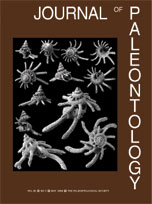A variety of Pennsylvanian sponges have been recovered from exposures along the shore of Lake Bridgeport and in nearby areas in Wise County, north-central Texas. Calcareous and hexactinellid sponges have locally weathered out of the Jasper Creek Shale (=upper Lake Bridgeport Shale) and the overlying Devil's Den Limestone of the Graford Formation, of Late Pennsylvanian Missourian age.
The Demospongea protomonaxonids Heliospongia excavata King, 1933, and Coelocladia spinosa Girty, 1908 are represented in the studied collections by several specimens, as is the new genus and species Luterospongia texana. Agelasid ceractinomorph demosponges are represented by the fissispongiid Fissispongia jacksboroensis King, 1938, the maeandrostiid Maeandrostia kansasensis Girty, 1908, and the girtycoeliid, Girtycoelia typica King, 1933. Sponges of the Class Hexactinellida and the amphidiscophorid Family Stiodermatidae are represented by an extensive suite of specimens of the new genus and species Dermosphaeroidalis irregularis. Representatives of the hexactinellid reticulosid sponges include some unusually large specimens of the vase-shaped Endoplegma calathus Finks, 1960, of the Family Docodermatidae, and fragmental specimens of ?Stereodictyum orthoplectum Finks, 1960, of the Family Stereodictyidae. One unclassified root tuft fragment is also described and illustrated.
Much of this diverse sponge fauna was endemic to the western embayment of Pangaea.





